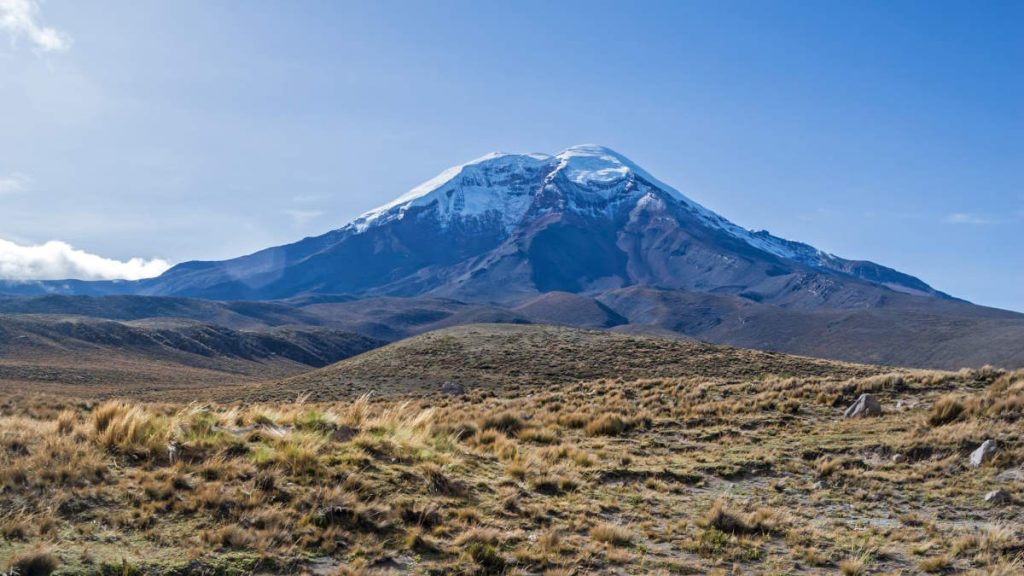Many often believe that Mount Everest, standing at a whopping 29,032 feet (8,849 meters), is the closest point to space from Earth. Yet, this is a misconception. The peak that holds this surprising honor is not even the tallest mountain on its own continent. Enter Chimborazo, a majestic peak located in the Andean mountain range of Ecuador.
While Chimborazo is not the tallest mountain in the World, or even on the Andes mountain range in South America (it is only the 39th highest peak in the entire Andes), it boasts a unique geographical phenomenon that sets it apart from the rest. Its summit is recognized as the farthest point on Earth’s surface from the Earth’s center. But how is this possible? The answer lies in the shape of our planet.
The Shape of Earth
Our Earth is not a perfect sphere. Instead, due to its rotation, the planet is an oblate spheroid, meaning it has a slight bulge around the equator. This equatorial bulge pushes the circumference of the Earth outwards in the middle, making regions around the equator slightly farther from the center than regions closer to the poles.
The summit of Chimborazo: the farthest point from the Earth’s center in the world
Located just one degree south of the equator, Chimborazo benefits from this equatorial bulge. Despite its peak reaching an elevation of 20,548 feet (6,263 meters) from the sea level – which is significantly shorter than many of the world’s highest mountains – the summit of Chimborazo is about 2,163 meters (7,096 feet) farther from the Earth’s core than the summit of Everest.

From a climber’s perspective, Chimborazo offers an adventure that is as challenging as some of the highest peaks in the world. The mountain is glaciated, and climbers must navigate crevasses, seracs, and other glacial features. While it might not have the same altitude as Everest or other 8,000-meter giants, its location near the equator means the air pressure is lower, making it feel as if you’re at a much higher altitude.
In addition to its geographical significance, Chimborazo has cultural and historical importance. It has been revered by local indigenous communities for centuries and has been the subject of many stories and myths.
So, while Chimborazo might not take the crown for the world’s tallest mountain, it reigns supreme in another, rather unexpected domain. Through the quirks of Earth’s shape, this Andean marvel stands as a testament to the wonders of our planet’s geography, challenging our perceptions and reminding us that there is always more to discover.
Chimborazo was considered the world’s tallest mountain in the past
In 1802, Mount Chimborazo was thought to be the world’s tallest mountain, and the ambitious young German naturalist, also German polymath, geographer, naturalist, explorer, and proponent of Romantic philosophy and science, Alexander von Humboldt (14 September 1769 – 6 May 185) set out to climb it.
Humboldt couldn’t reach the summit, but he did reach an altitude of 19,286 feet (5,878 meters), which was a new record for European mountaineers at that time (Incas had reached much higher altitudes centuries before). Humboldt’s trip to South America, including his trek up the side of Chimborazo, changed the way naturalists thought about altitude, vegetation, and volcanoes.
Chimborazo, now recognized as a dormant volcano, has historically been a beacon for intrepid mountaineers. Its majestic slopes, challenging terrains, and the allure of its unique geographical distinction have drawn climbers from all over the world.

But beyond the siren call to those with ambitions of scaling its heights, Chimborazo serves as a treasure trove of knowledge. For discerning naturalists, the mountain is more than just a peak; it’s a living classroom. From its base to its summit, the varying altitudes and climates present a tapestry of ecosystems. These diverse habitats offer invaluable insights into flora, fauna, and the intricate balance of life at different elevations. Researchers and biologists have long studied its slopes to understand how life adapts and thrives in such extreme conditions, making Chimborazo not just a mountaineering challenge, but a focal point for scientific exploration and discovery.
Sources
- Chimborazo on Wikipedia
- Alexander von Humboldt on Wikipedia
- “Chimborazo and Tungurahua, Ecuador” on the NASA website
- How Many Elephants are Left in the World in 2025? - August 17, 2025
- Moon Landings: All-Time List [1966-2025] - February 2, 2025
- What Is Max-Q and Why Is It Important During Rocket Launches? - January 16, 2025
